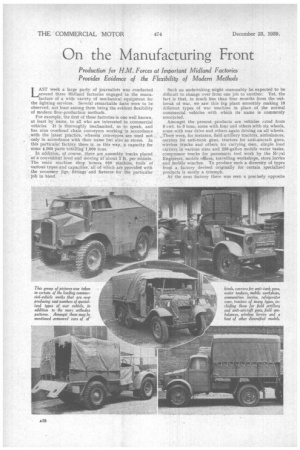On the Manufacturing Front
Page 30

Page 31

If you've noticed an error in this article please click here to report it so we can fix it.
Production for H.M. Forces at Important Midland Factories Provides Evidence of the Flexibility of Modern Methods
LAST week a large party of journalists was conducted around three Midland factories engaged in the manufacture of a wide variety of mechanical equipment for the fighting services. Several remarkable facts were to be observed, not least among them being the evident flexibility of modern flow-production methods.
For example, the first of these factories is one well known, at least by name, to all who are interested in commercial vehicles. It is thoroughly mechanized, so to speak, and has nine overhead chain conveyors working in accordance with the latest practice, wherein _conveyors -are used not only in accordance with their name but also as stores. In this particular factory there is, in this way, a capacity for some 4,000 parts totalling 1,000 tons.'
In addition, of course, there_are assembly tracks placed . . . ,
at a convenient level and moving at about-2 ft.. per Minute._ The main machine shop -houses_ 950 ina6hine. tools of . siatiouS types and capacities: all of which are provided with the necessary jigs, fittings and fixtUresfor the particiffar job in hand.
Such an undertaking might reasonably be expected to be difficult to change over from one job to another. Yet, the fact is that, in much less than four months from the outbreak of war, we saw this big plant smoothly making 18 different types of war machine in place of the normal commercial vehicles with which its name is commonly associated.
Amongst the present products are vehicles rated from 8 cwt. to 3 tons, some with four and others with six wheels, some with rear drive and others again driving on all wheels. There were., for instance, field artillery tractcirs, ambulances, carriers for anti-tank guns, tractors for anti-aircraft guns. wireless ;trucks and others, for carrying men, simple load carriers in .various sizes and 230-gallon mobile water tanks, compressor trucks for pneumatic tool work by the Ilcyal Engineers,mobile offices, travelling workshops, store lorries and mobile winches. To produce such a diversity of types from a factory devised originally for certain specialized products is surely a triumph.
At the next factory there was seen a precisely opposite
state of affairs. In this case the product was a cruiser•
tank, which was being made in considerable quantities, together with engines and transmission sets for assembly into similar tanks built in other factories. Two years ago these buildings • did not exist. They have been prepared especially for this present purpose and include a machine shop with twice as much space for assembly and stores.
Naturally, all the equipment is of the most modern type, but a remarkable tact is the almost complete absence of conveyors of any sort, apart from huge travelling cranes in the assembly shop. These cranes are capable of lifting a finished tank from one end of the shop and carrying it down to the other end over the tops of all the others in course of erection.
The engines for these particular vehicles, it is interesting to note, have 12 cylinders arranged in two banks with a narrow angle between, with overhead valves and camshafts.
Every engine is run for seven hours at gradually increasing speeds and is then tested on full load for three hours. Throughout that time the lubricating oil discharged from the engine (which, by the way, runs on the dry-sump principle) is purified by a centrifugal cleaner before being returned to a 700-gallon tank, from. which all engines on test diaw supplies for lubrication.
During our visit some of these tanks, together with some machine-gun carriers from a neighbouring factory, were demonstrated on a small test ground. Most of the usual stunts were performed and it was clear that, in Such matters as suspension and manoeuvrability, much progress has been made in the past few years.
Finally, a visit was paid to the largest rubber works in the country, where the elaborate test house was inspected, prior to a demonstration of the much-discussed bullet-proof tyre. Here it may be emphasized that the effect is not to deflect the bullet or to make it bounce oil in some miraculous manner, but simply to leave the tyre unaffected by the passage of the bullet through it.
Two army vehicles were used. On one the tyres had been shot several hours previously and the lorry returned from a test run on normal roads in time for inspection by the visiting party. Its tyres were not at all deflated and were still quite cool, showing that no undue deflection or internal friction had, occurred during the test.
We saw one of these tyres on the other vehicle given a couple of bullets from a service rifle and, apart from a small cut where each bullet entered the wall, the tyre was not affected. It still carried its load without abnormal deflection and when later the valve core was removed, air hissed out.




















































